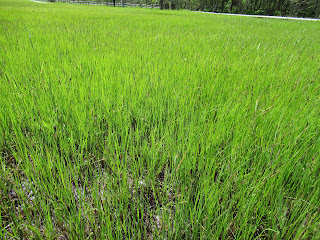 |
| The Gate to Hakone Botanical Garden of Wetlands |
A mini review of my posts from 2021. Hakone Botanical Garden of Wetlands 箱根湿生花園 is owned by Hakone Town and shields the wetland from urbanization by resort development. The place has well-tended native and otherwise vegetations for temperate mountainous area. The majority of the road inside the Garden is barrier-free so that wheelchair users are able to experience nature of National Treasure. The access to Botanical Garden is either by car from Gotemba 御殿場 IC of Tomei Expressway, or by bus from Shinjuku (with Odakyu Hakone Expressway Bus 小田急高速バス) or from Odawara (with Hakone-tozan Bus 箱根登山バス, commuter bus services to Kojiri/Togendai 湖尻/桃源台 Terminal; the timetable here). You get off your bus at Sengoku An’naijo-mae Stop 仙谷案内所前, walk 20m or so to the north and turn left at the corner of Lalique Museum. From there it’s one way stroll of less than 10 minutes to the entrance of Botanical Garden. Individual entrance fee for adult is 700 yen, but they have several discount tickets depending on the group visit, combination of the other museums of Hakone, and of transportation services. So please check their HP. Oh, payment is cash-only … gee. It’s too “bureaucratic” as a facility of municipality ...
 |
| From the bus stop, there is this sign showing the way to the garden. Follow it! |
 |
| Entrance to the garden. Immediately after the gate, they have a souvenir shop that has several garden plants and bonsais. If you have a garden, the place could be for your interest. |
As this is a botanical garden, it changes its presentation from season to season. In 2021, I tell you my visit for fall. This time it is spring. When we enter the gate and pass the admin office and souvenir shop, there next to the map of the garden is a bulletin board telling us the flowers we can meet for that day. It is helpful referring the list and the map to remember “what to see” at “which place.” As we’re introduced to the numbered place for each flower, we notice the garden is demarcated into 8 sections. They are (1) a forest of deciduous broad-leaved trees, (2) vegetation for dry grassland, (3) vegetation for low moor, (4) vegetation for wetland between low and high moors in altitude, (5) alpine vegetation, (6) vegetation for high moor, (7) plants found here in Sengokubara Wetland, and (8) wet forest. Have you noticed? The garden does not limit its collection to local flora, but introduced non-local species.
 |
| With the list of flowers in season |
There is a reason why they do not take puritanic approach for the garden collection. As this is the place open to the public for a fee, there is a demand to have flowering something year-round. “In order to fund the conservation plan for long term, we need money, you know? It’s important to encourage people who’re not so “in” for plant-admiring before coming here go home becoming a supporter for natural ecosystem. They can help funding more the place someday. Maintaining easy-to-understand presentation always is the key.” Mr. Katsuyama said. Understand. For that purpose, the inside garden is really well-maintained with variety of flowers. Here are some representations for this idea. Let’s start with Pteridophyllum racemosum.
This pretty flower is Japanese endemic species, but does not exist wild for Hakone. It loves floor of sub-alpine coniferous forest that does not exist in Kanagawa Prefecture. Here in the Botanical Garden, they show us in April pretty flowers under the planted conifers. The same is true for Asian skunk cabbage that does not exist in Hakone for wild, but they are uber-popular as it resonates with “natural beauty of Oze wetland.”
Or beautiful Paeonia japonica which can be found wild in Hakone, but categorized as NT by the Ministry of Environment of Japan.
 |
| The experiment area for wetland in Botanical
Garden. All the mowing here is done by hand. The effort is … huge, I guess. |
 |
| The spring fruit of such labour. Lots of Potentilla freyniana were flowering. |
 |
| The place is wet like this in
spring. Carex thunbergii were flowering. |
If you find environmental issues in Hakone, please make a contact with Hakone Visitor Centre 環境省箱根ビジターセンター
164 Motohakone, Hakone Town, Ashigarashimo-gun, Kanagawa Prefecture 250-0522
250-0522 神奈川県足柄下郡箱根町元箱根164
TEL:0460-84-9981
FAX:0460-84-5721
https://hakonevc.sunnyday.jp/









No comments:
Post a Comment